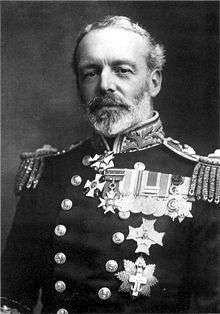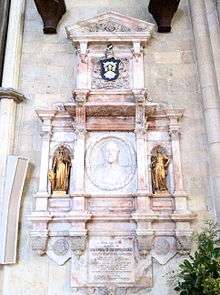Christopher Cradock
| Christopher Cradock | |
|---|---|
 Christopher Cradock | |
| Born |
2 July 1862 Hartforth, Richmond, North Yorkshire |
| Died |
1 November 1914 (aged 52) HMS Good Hope, South Pacific, off Coronel, Chile |
| Allegiance |
|
| Service/ |
|
| Years of service | 1875–1914 |
| Rank | Rear-Admiral |
| Commands held |
HMS Alacrity HMS Andromeda North America and West Indies Station |
| Battles/wars | |
| Awards |
Knight Commander of the Royal Victorian Order Companion of the Order of the Bath Order of the Crown (Prussia) |
Rear-Admiral Sir Christopher "Kit" George Francis Maurice Cradock KCVO CB SGM (2 July 1862 – 1 November 1914) was a British officer of the Royal Navy. He earned a reputation for great gallantry.[1] He was killed during the Battle of Coronel, an engagement with the German navy off the coast of Chile in the early part of World War I.
Early life and career
Cradock was born at Hartforth, Richmond, North Yorkshire.[1] He entered the Royal Navy in 1875, and saw action in the Mediterranean, serving with distinction. On 1 February 1900 he was appointed in command of the cruiser HMS Alacrity,[2] which later that year was posted to China during the Boxer Rebellion. He commanded a mixture of British, German and Japanese sailors including Charles C. Dix during the capture of the Taku forts, and was promoted captain in April 1901[3] and received the Prussian Order of the Crown with swords as a result.
On 24 March 1902 he was posted to HMS Andromeda at the Mediterranean Station, where from June that year he served as flag captain to Rear-Admiral Sir Baldwin Wake Walker.[4] Promoted to rear-admiral in 1910, he was involved in the sea rescue of the passengers and crew of the SS Delhi in December 1911, including Louise, Princess Royal (Daughter of King Edward VII and Queen Alexandra); her husband The Duke of Fife, and the king's grand-daughters. He was awarded the SGM and KCVO 28 February 1912; was knighted in an investiture at Buckingham Palace on 6 March 1912. In February 1913, he was given command of the North America and West Indies Station.[5] From at least 21 until 26 April 1914, Cradock was at Veracruz on HMS Essex during the United States occupation of Veracruz.[6][7]
Death at the Battle of Coronel

With the start of the First World War, in August 1914, Cradock, commanding the 4th Squadron of the Royal Navy and stationed at Stanley, had to deal with Admiral Maximilian von Spee's East Asia Squadron, which had sailed from the Pacific Ocean and had made it way towards the western coast of South America. Cradock's fleet was significantly weaker than Spee's, consisting of mainly elderly vessels manned by largely inexperienced crews. However, the orders he received from the Admiralty were ambiguous, and although they were meant to make him concentrate on the old but well-armed battleship Canopus, Cradock interpreted them as instructing him to seek and engage the enemy forces; clarifying instructions were not issued until 3 November, by which time the battle had already been fought.[8]
Cradock found Spee's force off Chile in the late afternoon of 1 November, and decided to engage, starting the Battle of Coronel. He tried to close the range to engage immediately, so that the enemy would have the setting sun in their eyes, but von Spee kept the range until dusk, when the British cruisers were silhouetted in the afterglow, while his ships were hidden by darkness. Heavily disadvantaged because of their awkward gun placements, and poorly trained crews, Cradock's flagship HMS Good Hope and the HMS Monmouth were destroyed with the loss of all 1570 lives, including his own; the light cruiser Glasgow and the armed merchant cruiser Otranto managed to escape. This battle was the first defeat of the Royal Navy in a naval action in more than a hundred years.[9]
Departing from Port Stanley he had left behind a letter to be forwarded to Admiral Hedworth Meux in the event of his death. In this he commented that he did not intend to suffer the fate of Rear-Admiral Ernest Troubridge, who in August had been courtmartialled for failing to engage the enemy despite the odds being severely against him, during the pursuit of the German warships Goeben and Breslau.[10] The Governor of the Falklands and the Governor's aide both reported that Cradock had not expected to survive.[11][12]
A monument to Admiral Cradock was placed in York Minster. It is on the east side of the North Transept towards the Chapter House entrance. There is another monument to Cradock in Catherington churchyard, Hampshire. There is a monument and a stained glass window in Cradock's memory in his parish church at Gilling West.[13] Having no known grave, he is commemorated by the Commonwealth War Graves Commission on Portsmouth Naval Memorial.[14]
There is a neighbourhood, near the Norfolk Naval Shipyard in Portsmouth, Virginia, named after him.
Personal life
Cradock never married, but kept a dog which accompanied him at sea. He commented that he would choose to die either during an accident while hunting (this was his favourite pastime), or during action at sea.
References
- 1 2 Paul G. Halpern, ‘Cradock, Sir Christopher George Francis Maurice (1862–1914)’, Oxford Dictionary of National Biography, Oxford University Press, 2004; online edn, Jan 2011 , accessed 13 May 2011.
- ↑ "Naval & Military intelligence". The Times (36053). London. 31 January 1900. p. 8.
- ↑ "Naval & Military intelligence". The Times (36433). London. 19 April 1901. p. 10.
- ↑ "Naval & Military intelligence". The Times (36724). London. 25 March 1902. p. 9.
- ↑ "Sir Christopher "Kit" Cradock, 1862-1914". History of war. Retrieved 3 January 2015.
- ↑ The Landing at Veracruz: 1914 by Jack Sweetman, ch. 6
- ↑ A Diplomat's Wife in Mexico by Edith O'Shaughnessy, ch. XXIV
- ↑ Halpern, p. 242-4
- ↑ Halpern, p. 244-6
- ↑ 'Castles', p. 221.
- ↑ 'Castles', p. 219, citing Marder Vol II, p. 111.
- ↑ 'Castles', p. 219, citing Coronel and the Faulklands, p. 92.
- ↑ flickr
- ↑ Christopher Cradock Commonwealth War Graves Commission.
Sources
- "Good Hope Sunk". The Times (40689). 7 November 1914. p. 9.
- "The late Admiral Cradock". The Times (40696). 14 November 1914. p. 11.
- Robert Massie (2004). Castles of steel: Britain, Germany and the winning of the Great War at sea. London: Jonathan Cape. ISBN 0-224-04092-8.
- Arthur Marder (1961–1970). From the Dreadnought to Scapa Flow (5 Vols). London: Oxford University Press.
- Paul Halpern (1994). A naval history of World War I. Annapolis: Naval Institute Press.
Further reading
- Cradock, Christopher (1889). Sporting notes in the Far East. Griffith Farran Okeden & Welsh.
- Cradock, Christopher (1894). Wrinkles in Seamanship.
- Cradock, Christopher (1908). Whispers from the Fleet.
External links
| Wikimedia Commons has media related to Christopher Cradock. |
- The Dreadnought Project: Christopher Cradock
| Military offices | ||
|---|---|---|
| Preceded by Vacant (last held by Sir Day Bosanquet) |
Commander-in-Chief, North America and West Indies Station 1913–1914 |
Succeeded by Robert Hornby |